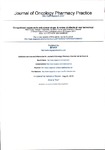Occupational exposure to anti-cancer drugs: A review of effects of new technology
| dc.contributor.author | Vyas, N | |
| dc.contributor.author | Yiannakis, D | |
| dc.contributor.author | Turner, A | |
| dc.contributor.author | Sewell, GJ | |
| dc.date.accessioned | 2015-10-27T16:11:34Z | |
| dc.date.available | 2015-10-27T16:11:34Z | |
| dc.date.issued | 2014-08 | |
| dc.identifier.issn | 1078-1552 | |
| dc.identifier.issn | 1477-092X | |
| dc.identifier.uri | http://hdl.handle.net/10026.1/3704 | |
| dc.description.abstract |
<jats:p> Because anti-cancer drugs are non-selective, they affect both cancerous and non-cancerous cells. Being carcinogenic and mutagenic, many anticancer drugs therefore present a major health risk to healthcare staff working with them. This paper reviews the means by which exposure to anti-cancer drugs in the workplace may be monitored, assessed and reduced. Both biological monitoring, using non-selective methods or compound-selective methods, and environmental monitoring have provided information on the nature and degree of exposure in the workplace. Pharmaceutical isolators, used for the compounding of cytotoxic IV infusions and the preparation of injectable drugs, provide a physical barrier between pharmacists and cytotoxic drugs and reduce direct exposure. However, the interior of isolators and the contents thereof (e.g. infusion bags and syringes) are readily contaminated by aerosols and spillages and afford a secondary source of exposure to pharmacists, nurses and cleaning staff. Closed system transfer devices (CSTDs), designed to prohibit the transfer of contaminants into the working environment during drug transfer between the vial and syringe, have been successful in further reducing, but not eliminating surface contamination. Given that the number of patients requiring treatment with chemotherapeutic agents is predicted to increase, further efforts to reduce occupational exposure to anti-cancer drugs, including the refinement and wider use of CTSDs, are recommended. </jats:p> | |
| dc.format.extent | 278-287 | |
| dc.format.medium | Print-Electronic | |
| dc.language | en | |
| dc.language.iso | eng | |
| dc.publisher | SAGE Publications | |
| dc.subject | Anti-cancer drugs | |
| dc.subject | biological monitoring | |
| dc.subject | environmental monitoring | |
| dc.subject | closed system drug transfer device | |
| dc.subject | pharmaceutical isolator | |
| dc.title | Occupational exposure to anti-cancer drugs: A review of effects of new technology | |
| dc.type | journal-article | |
| dc.type | Article | |
| plymouth.author-url | https://www.ncbi.nlm.nih.gov/pubmed/23975555 | |
| plymouth.issue | 4 | |
| plymouth.volume | 20 | |
| plymouth.publication-status | Published | |
| plymouth.journal | Journal of Oncology Pharmacy Practice | |
| dc.identifier.doi | 10.1177/1078155213498630 | |
| plymouth.organisational-group | /Plymouth | |
| plymouth.organisational-group | /Plymouth/Faculty of Health | |
| plymouth.organisational-group | /Plymouth/Faculty of Science and Engineering | |
| plymouth.organisational-group | /Plymouth/Faculty of Science and Engineering/School of Geography, Earth and Environmental Sciences | |
| plymouth.organisational-group | /Plymouth/REF 2021 Researchers by UoA | |
| plymouth.organisational-group | /Plymouth/REF 2021 Researchers by UoA/UoA03 Allied Health Professions, Dentistry, Nursing and Pharmacy | |
| plymouth.organisational-group | /Plymouth/REF 2021 Researchers by UoA/UoA03 Allied Health Professions, Dentistry, Nursing and Pharmacy/UoA03 Allied Health Professions, Dentistry, Nursing and Pharmacy MANUAL | |
| plymouth.organisational-group | /Plymouth/REF 2021 Researchers by UoA/UoA07 Earth Systems and Environmental Sciences | |
| plymouth.organisational-group | /Plymouth/Research Groups | |
| plymouth.organisational-group | /Plymouth/Research Groups/BEACh | |
| plymouth.organisational-group | /Plymouth/Research Groups/Institute of Health and Community | |
| plymouth.organisational-group | /Plymouth/Research Groups/Marine Institute | |
| plymouth.organisational-group | /Plymouth/Users by role | |
| plymouth.organisational-group | /Plymouth/Users by role/Academics | |
| dc.publisher.place | England | |
| dc.identifier.eissn | 1477-092X | |
| dc.rights.embargoperiod | Not known | |
| rioxxterms.versionofrecord | 10.1177/1078155213498630 | |
| rioxxterms.licenseref.uri | http://www.rioxx.net/licenses/all-rights-reserved | |
| rioxxterms.type | Journal Article/Review |


